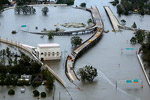According to a new review of 27 climate models, scientists say the global climate is likely to experience a warmth as great as any in the last 65 million years, only much, much faster. According to the study published today in Science, the Earth’s land temperature will rise by 4 degrees Celsius (7.2 degrees Fahrenheit) from pre-industrial levels by 2100 if we continue on our current emissions trajectory.
“What is perhaps most noteworthy is the rate of change,” says co-author Noah Suresh Diffenbaugh with Stanford University. “For instance, the rapid global warming event that occurred some 55 million years ago was as large as these warming projections, but that event occurred over many thousands of years, not a mere century.”
If it occurs, the temperature rise would be at least 10 times faster than anything seen since the mass extinction of the dinosaurs, creating unknown impacts on the Earth’s species and ecosystems.
“It’s not easy to intuit the exact impact from annual temperatures warming by 6 C,” Diffenbaugh said. “But this would present a novel climate for most land areas. Given the impacts those kinds of seasons currently have on terrestrial forests, agriculture and human health, we’ll likely see substantial stress from severely hot conditions.”
More warming, the scientists warn, will certainly intensify severe weather and make today’s hottest summers the norm. The scientists write that this warming over such a short span could make it impossible for many species to adapt.
“Species and ecosystems will encounter not only a range of climate conditions that is potentially different from any in the past but also the broader conditions of the Anthropocene , in which human actions either dominate or strongly influence a wide range of Earth system processes,” the researchers write.
Even if a species is capable of outrunning global climate change, it may not be able to in the face of habitat destruction, pollution, invasive species, and overexploitation. The scientists note that the combination of rapid global warming and human ecological impacts “will
present terrestrial ecosystems with an environment that is unprecedented in recent evolutionary history.”
Greenhouse gas emissions from burning fossil fuels, deforestation, and industrial agriculture have already warmed the Earth around 0.8 degrees Celsius (1.44 degrees Fahrenheit) over the last hundred years. The warming to date has led to rising sea levels, worsening heatwaves, melting Arctic sea ice, and vanishing glaciers among other impacts.
Still, the scientists note that a number of uncertainties underpin the path of future warming, including feedback processes like the carbon cycle and clouds. However, the largest of the uncertainties is how much additional fossil fuels will human civilization burn? While some warming is unavoidable given past emissions, the worst impacts could still be eluded.
“The future of the planet lies in our hands,” notes co-author Chris Field also with Stanford.

Top: The change in annual temperature projected for the late 21st century using simulations from 27 global climate models. The change is calculated as the 2081-2100 mean minus the 1986-2005 mean. Bottom: The velocity of climate change required to maintain the current annual temperature should the late-21st-century climate change occur. The velocity is calculated foreach location by identifying the closest location in the future climate that has the same annual temperature as the starting location has in the present climate.
Image courtesy of Noah Diffenbaugh.
CITATION: N.S. Diffenbaugh and C.B. Field. Changes in Ecologically Critical Terrestrial Climate Conditions. Science. 2013.
Related articles
Drastic cuts to greenhouse gases could save hundreds of U.S. cities from watery grave

(08/01/2013) More than 1,700 American cities and towns – including Boston, New York, and Miami – are at greater risk from rising sea levels than previously feared, a new study has found. By 2100, the future of at least part of these 1,700 locations will be “locked in” by greenhouse gas emissions built up in the atmosphere, the analysis published in the Proceedings of the National Academy of Sciences on Monday found.
(07/30/2013) Rapid thawing of the Arctic could trigger a catastrophic “economic timebomb” which would cost trillions of dollars and undermine the global financial system, say a group of economists and polar scientists. Governments and industry have expected the widespread warming of the Arctic region in the past 20 years to be an economic boon, allowing the exploitation of new gas and oilfields and enabling shipping to travel faster between Europe and Asia.
Yukon Flats experiencing more wildfires now than in the last 10,000 years
(07/22/2013) The Yukon Flats area of Alaska is today burning more frequently and severely than it has in the last 10,000 years, according to new research published in the Proceedings of the National Academy of Sciences (PNAS). Looking at charcoal fragments from 14 deep lakes in the region, scientists were able to reconstruct the fire history of this particular forest, which covers around 2,000 square kilometers. Scientists have long warned that as the temperature worldwide continue to rise from climate change, wildfires are likely to become more common.
Featured video: mangroves in El Salvador imperiled by climate change
(07/17/2013) A new short video by Friends of the Earth International highlights the impacts of climate change on mangroves in El Salvador, which local fishermen depend on for their livelihoods.
Forests may be using less water as CO2 rises
(07/11/2013) Forests may be becoming more efficient in their use of water as atmospheric carbon dioxide levels rise, reports a new study in Nature.
Rising temperatures are triggering rainforest trees to produce more flowers
(07/09/2013) Slight rises in temperatures are triggering rainforest trees to produce more flowers, reports a new study published in the journal Nature Climate Change.
Hurricane intensity, frequency to increase with climate change
(07/08/2013) Warmer ocean temperatures will increase the frequency and intensity of tropical cyclones, typhoons and hurricanes in “most locations” this century, concludes a new study based on simulations using six global climate models.
In age of climate change, Australia’s vast coal fields could become worthless
(07/02/2013) Australia’s huge coal industry is a speculative bubble ripe for financial implosion if the world’s governments fulfill their agreement to act on climate change, according to a new report. The warning that much of the nation’s coal reserves will become worthless as the world hits carbon emission limits comes after banking giant Citi also warned Australian investors that fossil fuel companies could do little to avoid the future loss of value.
Campaign contributions suggest dead-end for Congressional action on climate
(06/26/2013) Sources of campaign contributions to members of Senate suggest Congress will be unlikely to take action on comprehensive climate legislation, indicates data collected by MapLight, a group that tracks money’s influence on politics.
After long wait, Obama lays out fight against climate change

(06/25/2013) Five years after being elected president and six months after winning a second term, President Obama today gave his first speech devoted solely to climate change and announced several executive actions to begin weaning the United States (historically the largest emitter of greenhouse gases) off fossil fuels. At Georgetown University today, Obama stated that his administration would expand renewable energy projects on federal lands, raise energy efficiency standards on appliances, and, most importantly, limit carbon pollution from both existing and new power plants, which represent about 40 percent of the U.S.’s emissions. Obama also noted that the U.S. would spearhead global efforts to combat climate change which is pushing sea levels higher, melting glaciers and sea ice, exacerbating fires, imperiling species, and worsening extreme weather worldwide.
NASA image shows nearly ice-free Alaska as temps top 96 degrees
(06/24/2013) After a colder-than-average spring, Alaska is suffering a sudden and record-breaking heatwave. Temperatures on Monday, June 17th hit a stunning 96 degrees Fahrenheit (35 degrees Celsius) in Talkeetna, Alaska, just below the state’s highest temperature ever record of 98 degrees Fahrenheit in 1969. On the same day, NASA’s Terra Satellite’s Moderate Resolution Imaging Spectroradiometer (MODIS) took a rare image of a cloud-free Alaska.
Conserving top predators results in less CO2 in the air

(06/19/2013) What does a wolf in Yellowstone National Park have in common with an ambush spider on a meadow in Connecticut? Both are predators and thus eat herbivores, such as elk (in the case of wolves) and grasshoppers (in the case of spiders). Elk and grasshoppers also have more in common than you probably imagine: they both consume large quantities of plant matter. While scientists have long-known that predators lead to carbon storage by reducing herbivore populations, a new study reveals a novel way in which top predators cause an ecosystem to store more carbon.
Seabirds face big problems as sea levels rise

(06/19/2013) Migratory shorebird populations are at great risk from rising sea levels due to global climate change, warns a recent paper in Proceedings of the Royal Society B. These birds play an important role in the distribution of nutrients within wetland and coastal ecosystems, and their loss could have unknown consequences for the rest of the world.
Warming world hits fig wasps and figs

(06/19/2013) Recent experiments concerning hugely-important fig plants (Ficus) and their relationship with small, short-lived fig wasps suggest dire potential consequences due to human induced climate change, finds a study published in the journal Biology Letters. The researchers collected four species of adult female fig wasps from the lowland tropical forests of Singapore to test their tolerance to gradually increased temperatures.
Should zoos educate the public about climate change?

(06/18/2013) Zoos are usually thought of as entertainment destinations. As a place to take the kids on a nice afternoon, they are sometimes perceived to lack the educational heft of an art museum or a theatre. However, over the past few decades many of the world’s best zoos and aquariums have also worked to educate their visitors about conservation issues, in addition to funding and supporting programs in the field to save the ever-growing number of imperiled species. But as threats to the world’s species mount—including climate change—many are beginning to ask what, if anything, zoos and aquariums should do to address the global environmental crisis.